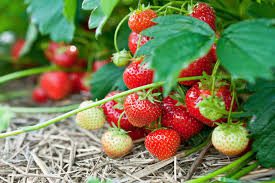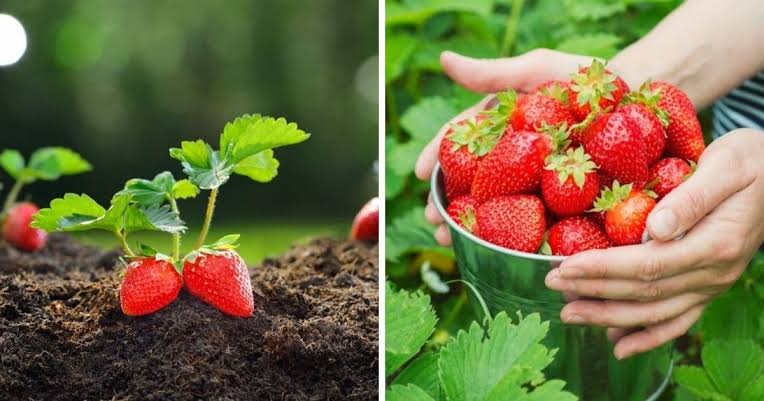Strawberry is a delightful fruit loved by many. Its vibrant red color and sweet taste make it a favorite in various dishes and desserts. The strawberry plant, belonging to the Rosaceae family, produces these juicy, red berries. These berries are not just tasty but also packed with nutrients.
When you bite into a ripe strawberry, you experience a burst of sweetness with a hint of tartness. The texture is juicy and slightly grainy, providing a refreshing sensation. Strawberries are not only delicious but also low in calories, making them a guilt-free snack. They are rich in vitamin C, manganese, folate, and antioxidants, contributing to their health benefits.
Strawberries are versatile and can be enjoyed in numerous ways. You can eat them fresh, add them to salads, or blend them into smoothies. Additionally, they make scrumptious toppings for desserts like ice cream and cakes. The possibilities with strawberries are endless, adding a burst of flavor to your culinary adventures.
These berries are not just tasty; they also offer a range of health benefits. The high vitamin C content in strawberries supports a healthy immune system and promotes skin health. Antioxidants present in strawberries help combat oxidative stress in the body, potentially reducing the risk of chronic diseases.
Cultivating strawberries is a fascinating process. They thrive in well-drained soil and require ample sunlight. The strawberry plants produce runners, which are shoots that extend from the main plant and develop into new ones. This unique reproduction method contributes to the widespread growth of strawberry plants.
Strawberry festivals are popular events that celebrate this beloved fruit. These festivals often feature a variety of strawberry-themed activities, including strawberry picking, recipe contests, and live music. It’s a joyful occasion that brings communities together to appreciate the goodness of strawberries.
In addition, strawberries are more than just a tasty treat; they are a nutritional powerhouse wrapped in a small, red package. Whether enjoyed fresh, incorporated into dishes, or celebrated at festivals, strawberries bring joy and flavor to our lives. So, the next time you bite into a juicy strawberry, savor not just the taste but also the health benefits and the delightful experiences this little berry brings.
Read Also: Proper Management of Pig Breeding Stocks, Piglets, Weaners, Growing, and Finishing Pigs
How to Grow and Care for Strawberry

Growing and caring for strawberries can be a rewarding experience. To successfully cultivate these delicious berries, consider the following tips:
1. Soil Preparation: Start by choosing a well-draining soil for your strawberry plants. Sandy loam or loamy soil is ideal. Ensure proper drainage to prevent waterlogging, which can harm the roots.
2. Planting: Plant strawberries in early spring or late summer, depending on your climate. Choose healthy strawberry plants from a reputable source. Space them about 12-18 inches apart in rows, giving them room to spread.
3. Sunlight: Strawberries thrive in full sunlight. Ensure they receive at least 6-8 hours of direct sunlight daily for optimal growth and fruit production.
4. Watering: Keep the soil consistently moist but not waterlogged. Water at the base of the plants to avoid wetting the leaves, as this can lead to diseases. Consider using a drip irrigation system for efficient watering.
5. Mulching: Apply a layer of mulch around the plants to retain soil moisture, suppress weeds, and keep the berries clean. Straw or shredded leaves make excellent mulch for strawberries.
6. Fertilization: Feed your strawberry plants with a balanced fertilizer during the growing season. Avoid excessive nitrogen, as it can promote lush foliage at the expense of fruit production.
7. Runners: Strawberries produce runners, which are shoots that extend from the main plant. Allow a few runners to develop for new plants, but trim excess ones to focus the plant’s energy on fruiting.
8. Pest Control: Keep an eye out for common pests like aphids and spider mites. Use natural remedies or insecticidal soap to control infestations without harming the plants.
9. Disease Prevention: Strawberries can be susceptible to diseases like powdery mildew and gray mold. Provide adequate air circulation by spacing plants properly, and remove any infected leaves promptly.
10. Harvesting: Harvest strawberries when they are fully ripe and have developed their characteristic red color. Gently pick the berries to avoid damaging the delicate fruit and leave the caps on to extend shelf life.
11. Winter Care: In colder climates, protect strawberry plants from winter frost by applying a thick layer of straw mulch. This helps insulate the plants and prevents winter damage.
By following these growing and care guidelines, you can enjoy a bountiful harvest of fresh, homegrown strawberries. Whether in a garden bed, containers, or hanging baskets, these tips will help you nurture healthy strawberry plants and savor the fruits of your labor.
Read Also: Nutrient Requirement of Pigs and Swine Feeding Methods
The Benefits of Strawberries

Strawberries offer a plethora of benefits, making them not only a delightful treat but also a nutritious addition to your diet. Here are some of the key benefits of including strawberries in your meals:
1. Rich in Vitamin C: Strawberries are an excellent source of vitamin C, a powerful antioxidant that supports a healthy immune system, aids in collagen production for skin health, and helps the body absorb iron.
2. Antioxidant Power: Packed with antioxidants such as anthocyanins and quercetin, strawberries help combat oxidative stress in the body. These antioxidants may contribute to reducing the risk of chronic diseases.
3. Heart Health: The high levels of anthocyanins in strawberries have been linked to a lower risk of heart disease. These compounds may help regulate blood pressure and improve overall cardiovascular health.
4. Fiber Content: Strawberries are a good source of dietary fiber, promoting digestive health and helping regulate blood sugar levels. The fiber content also contributes to a feeling of fullness, potentially aiding in weight management.
5. Manganese for Metabolism: Strawberries contain manganese, a trace mineral essential for metabolism. Manganese plays a role in breaking down carbohydrates and proteins, supporting energy production.
6. Folate for Pregnancy: Folate, also known as vitamin B9, is present in strawberries and is crucial for cell division and DNA synthesis. It is especially important for pregnant women to support fetal development.
7. Skin Health: The combination of vitamin C and antioxidants in strawberries promotes skin health by protecting against free radical damage, reducing signs of aging, and contributing to a radiant complexion.
8. Cancer-Fighting Properties: Studies suggest that the antioxidants in strawberries may have anti-cancer properties, potentially inhibiting the growth of cancer cells and reducing the risk of certain cancers.
9. Blood Sugar Regulation: Strawberries have a low glycemic index, meaning they have a minimal impact on blood sugar levels. This makes them a suitable option for individuals managing diabetes or those looking to maintain stable blood sugar levels.
10. Hydration: With a high water content, strawberries contribute to overall hydration. Including water-rich foods in your diet can support bodily functions and help maintain healthy skin.
Incorporating strawberries into your diet is a delicious way to enjoy these health benefits. Whether eaten fresh, added to salads, blended into smoothies, or used as toppings for various dishes, strawberries provide a burst of flavor along with valuable nutrients for your well-being.
Uses of Strawberries
Strawberries are versatile fruits with a wide range of culinary uses. Here are some delightful ways to incorporate strawberries into your meals and snacks:
1. Fresh Snacking: Enjoy strawberries in their simplest form – fresh and ripe. Wash them thoroughly and savor the sweet, juicy goodness as a healthy snack.
2. Fruit Salads: Add a burst of color and flavor to your fruit salads by including sliced strawberries. Their sweetness complements a variety of fruits, creating a refreshing and nutritious dish.
3. Smoothies: Blend strawberries into smoothies for a delicious and nutritious beverage. Combine them with yogurt, other fruits, and a liquid of your choice for a refreshing drink.
4. Dessert Toppings: Elevate your desserts by using strawberries as toppings. Whether it’s ice cream, cake, or yogurt, sliced strawberries add a delightful sweetness and vibrant color.
5. Jams and Preserves: Make your own strawberry jam or preserves. Boil down fresh strawberries with sugar to create a flavorful spread for toast, pastries, or desserts.
6. Baked Goods: Incorporate strawberries into your baking recipes. Add sliced strawberries to muffins, pancakes, or even bake them into pies and tarts for a fruity twist.
7. Salads: Enhance your green salads with the addition of sliced strawberries. The sweetness pairs well with various greens, nuts, and cheeses, creating a well-balanced and tasty salad.
8. Salsas: Create a refreshing salsa by combining diced strawberries with ingredients like tomatoes, onions, cilantro, and lime juice. This strawberry salsa is a flavorful accompaniment to grilled chicken or fish.
9. Infused Water: Upgrade your water by infusing it with strawberries. Add sliced strawberries to a pitcher of water for a hint of natural sweetness and a burst of flavor.
10. Cocktails and Mocktails: Strawberries make excellent additions to beverages. Muddle them into cocktails for a fruity twist, or use them to garnish non-alcoholic mocktails for a refreshing touch.
11. Breakfast Cereals: Sprinkle sliced strawberries on your morning cereal or oatmeal. Their natural sweetness adds a delightful kick to your breakfast.
12. Dried Strawberries: Dehydrate strawberries to create a delicious and portable snack. Dried strawberries can be enjoyed on their own or added to trail mixes.
From breakfast to dessert, strawberries can be incorporated into various dishes, enhancing both the flavor and nutritional content of your meals. Get creative in the kitchen and explore the many ways you can enjoy the delicious versatility of strawberries.
Read Also: The Impact of Waste to Art Business

